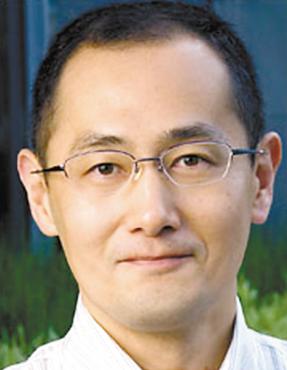山中伸弥

山中伸弥(Shinya Yamanaka)
山中伸弥,1962年出生于日本大阪府,日本医学家,京都大学再生医科研究所干细胞生物系教授,大阪市立大学医学博士(1993年),美国加利福尼亚州旧金山心血管疾病研究所高级研究员。山中伸弥是诱导多功能干细胞(iPScell)创始人之一。2007年,他所在的研究团队通过对小鼠的实验,发现诱导人体表皮细胞使之具有胚胎干细胞活动
特征的方法。此方法诱导出的干细胞可转变为心脏和神经细胞,为研究治疗目前多种心血管绝症提供了巨大助力。这一研究成果在全世界被广泛应用,因为其免除了
使用人体胚胎提取干细胞的伦理道德制约。山中伸弥也因此获得2009年拉斯克基础医学奖。同时他在2008年获颁邵逸夫生命科学与医学奖。并于2011年
获得国际最高学术大奖之一的沃尔夫医学奖,与其一起获奖的还有美国怀特黑德研究所的Rudolf
Jaenisch。2012年,山中伸弥与美国软件工程师利努斯·托瓦兹获得芬兰“千年技术奖”,二人分别获得60万欧元的奖金。2012年10月8日,瑞典诺贝尔奖评审团宣布,日本京都大学山中伸弥(Shinya Yamanaka)与英国发育生物学家约翰·戈登(John Gurdon)因在细胞核重新编程研究领域的杰出贡献,从而获得2012年诺贝尔生理学或医学奖。
1987年 3月:神户大学医学院毕业
1987年7月:国立大阪病院临床研修医
1993年 3月:大阪市立大学医学研究科博士毕业
1993年4月:格拉斯通研究所(Gladstone Institute)博士研究员
1996年 1月:日本学术振兴会特别研究员
1996年10月:大阪市立大学医学部助手(药理学教室)
1999年12月:奈良先端科学技术大学院大学遗传因子教育研究中心助理教授
2003年 9月:升任奈良先端科学技术大学院大学遗传因子教育研究中心教授
2004年10月:京都大学再生医科学研究所(Institute for Frontier Medical Sciences)教授(再生诱导研究分野)
2008年 1月:京都大学物质-细胞统合系统据点iPS细胞研究中心长
2007年 Meyenburg Award(Meyenburg基金会 [Meyenburg Foundation]/德国癌症研究中心 [ Deutsches Krebsforschungszentrum, DKFZ])(德国)
2008年 《时代》杂志“世界百大影响力人物”(The World's Most Influential People)(美国)
2008年 罗伯特•科赫奖(德国)
2008年 科学技术特别奖(日本)
2008年 邵逸夫生命科学与医学奖(香港)
2009年 拉斯克基础医学研究奖(美国)
2011年 沃尔夫医学奖(以色列)
2012年 诺贝尔生理学或医学奖
Shinya Yamanaka, M.D., Ph.D.
Senior Investigator, Gladstone Institute of Cardiovascular Disease
L.K. Whittier Foundation Investigator in Stem Cell Biology
Professor of Anatomy
University of California, San Francisco
Email:syamanaka@gladstone.ucsf.edu
Telephone: 415-734-2710
Fax: 415-355-0960
Address:
1650 Owens Street
San Francisco, CA 94158
Areas of investigation
The goal of our laboratory is to generate pluripotent stem cells from human somatic cells. Somatic cells can be reprogrammed either by nuclear transfer into oocytes or by fusion with embryonic stem (ES) cells. These results suggest that oocytes and ES cells contain factors that induce reprogramming. By identifying these factors, it should be possible to induce pluripotency in somatic cells without using embryos or oocytes.
Significance
ES cells, derived from the inner cell mass of mammalian blastocysts, can grow indefinitely while maintaining pluripotency. These properties have led to expectations that ES cells might be useful to treat a host of degenerative diseases, such as Parkinson’s disease and diabetes, as well as injuries, such as spinal cord injury. However, clinical application of human ES cells raises issues about the ethical use of human embryos and problems with tissue rejection after implantation. By generating pluripotent cells directly from somatic cells, we can circumvent these issues. Once established, these cells may be used in regenerative medicine and also to elucidate disease mechanisms and to screen drugs.
Approaches
We hypothesized that factors with important roles in maintaining the pluripotency of ES cells may also be critical for inducing pluripotency. The long-term maintenance of pluripotency in ES cells requires transcription factors that are specifically expressed in pluripotent cells (e.g., Oct3/4, Sox2) and activation of tumor-related genes (e.g., Stat3, c-Myc, b-catenin).
We recently showed that, in addition to these factors, the transcription factors Nanog and Klf4 and the Ras-like protein ERas play important roles in the self-renewal of mouse ES cells. Thus, these factors are candidates for pluripotency-inducing factors.
To evaluate these candidates, we developed systems in which the induction of pluripotency can be detected by expression of a marker gene. We genetically modified mice by inserting reporter cassettes into genes specifically expressed in ES cells and early embryos, such asFbx15andNanog. Somatic cells derived from the mice do not express the marker genes, but when reprogrammed, the cells should become positive for these markers.
Contributions
We showed that pluripotent stem cells can be generated from adult mouse tail tip fibroblasts and adult human fibroblasts by the retrovirus-mediated transfection of four transcription factors, Oct3/4, Sox2, c-Myc, and Klf4. We designated these cells as induced pluripotent stem (iPS) cells. Mouse iPS cells are indistinguishable from ES cells in morphology, proliferation, gene expression, and teratoma formation. When transplanted into blastocysts, mouse iPS cells derived from mouse embryonic fibroblasts can give rise to adult chimeras, which are competent for germline transmission. These results are proof-of-principle that pluripotent stem cells can be generated from somatic cells by the combination of a small number of factors.
Some questions addressed in ongoing studies
1. Which types of somatic cells are ideal as a source for iPS cell induction?
2. What are the molecular mechanisms underlying reprogramming by the four factors?
3. Can the use of retrovirus, which may result in tumorigenesis, be replaced by other methods?
4. Can small molecules, instead of genes, induce pluripotency in somatic cells?
附件列表
词条内容仅供参考,如果您需要解决具体问题
(尤其在法律、医学等领域),建议您咨询相关领域专业人士。
